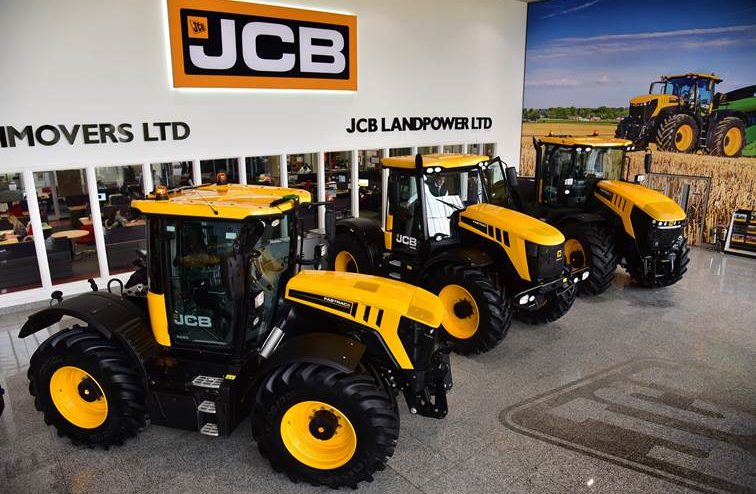
JCB engineering and assembly teams have celebrated the contribution made to farming productivity by the Fastrac 3000 Series tractor over the past 20 years.
When introduced in 1998, the 150hp Fastrac 3155 and 170hp 3185 built on the success of their 100 Series predecessors in establishing the JCB Fastrac as a uniquely productive and versatile machine on farms around the World.
Subsequent models brought increased power, greater fuel economy, lower running costs and reduced emissions, a new JCB semi-powershift transmission for more productive field and transport operations. They also added to the Fastrac’s unique features with anti-lock braking for added on- and off-road safety, and selectable transport power boost, which enables drivers to choose between optimum economy and outright performance.
Now, as the 3000 Series bows out of production at the Cheadle factory in Staffordshire, JCB’s considerable design, engineering and production resources are focused entirely on the new generation 4000 and 8000 Series designs, which take the Fastrac to new heights of performance and productivity with advanced CVT transmissions, all-new cabs and integrated guidance and ISOBUS electronics.
The final Fastrac 3230 Xtra off the assembly line is destined for a customer in Australia, where the tractor’s working speed, stability, traction and ride comfort have made it a popular choice for fertiliser application and other spreading operations, often carried out across difficult terrain.
John Smith, Managing Director of JCB Agriculture, said: “The 3000 Series tractors are direct descendants of the Fastrac models that introduced farmers and contractors to the new concept of a machine capable of moving farm inputs and produce more speedily and more safely than ever before, while giving operators unprecedented levels of comfort.
“Over the past 20 years, they have gained more power, better transmissions, upgraded cab equipment and new features that added to their control and performance capabilities, and helped the tractors win over many fans to the advanced Fastrac concept.
“It’s an important chapter in the ongoing Fastrac story that’s worth celebrating as we now focus solely on a new generation of Fastrac tractors that further increase the versatility, performance and productivity of this unique product.”
Today’s Fastrac
The JCB Fastrac range now comprises three 4000 Series tractors from 175-235hp with a top speed of 60kph, multi-mode four-wheel steering and ‘active’ suspension all round, and the two-model Fastrac 8000 Series with 306-348hp and capable of 70kph.
With the all-new Command Plus cab providing excellent all-round visibility and new levels of driver comfort, the seamless speed control versatility of CVT transmissions and built-in GPS guidance and ISOBUS implement control capability, these machines raise the bar for tractor design, performance and comfort within their class.
They both set new standards for field work applications while maintaining distinct advantages for haulage operations by building on the Fastrac’s unique combination of suspension for both axles, dual circuit four-wheel braking with large external discs, and anti-lock brake control to maintain the highest possible level of braking performance and steering control on all surfaces.
With these features, Fastrac 4000 and 8000 Series tractors complete journeys more quickly and are less tiring to drive, so operators can work comfortably for more hours in the day and raise overall productivity by performing fast in the field as well as on the road.
In 1998, the Fastrac 135, 155 and 185 were replaced by the new-look 150hp (DIN) Fastrac 3155 and 170hp (DIN) 3185. They were identified by sleeker styling and featured a new 65kph Autoshift 54×18 transmission with three-speed powershift and automatic shifting modes to suit different applications.
New triple link front suspension reduced the tractors’ turning circle by up to 2 metres and an optional multi-function performance monitor was amongst a number of cab interior revisions, while the Smoothshift transmission that entered production in 2001 brought reduced service requirements and added durability by using an oil-immersed wet clutch.
Later that year, the JCB Fastrac scored another of its many ‘firsts’ with the introduction of an electronic anti-lock braking system (ABS) that works effectively on loose-surface farm tracks as well as on low grip tarmac and other hard surfaces, bringing added safety to the Fastrac’s high speed transport capability.
Rounded engine hood and roof panel styling marked the 2002 introduction of the 193hp 3190 and 220hp 3220, both powered by engines with electronic fuel pump management that improved economy and power delivery, and generated up to 12% more torque.
Increased hitch capacity front and rear, and a new control console in the cab with short-throw gear lever and electric spool valves further improved the tractors’ equipment levels.
In 2003, the 173hp 3170 acquired the same styling and specification, while the 2006 introduction of common rail fuel injection engines brought more torque at lower revs plus a further power increase to the now two-model range comprising the 198hp 3200 and 230hp 3230.
Major powertrain changes came with the 2011 launch of the Fastrac 3000 Xtra tractors, which introduced JCB’s P-Tronic 24×9 semi-powershift transmission with slicker gear changes from six powershift steps, and the unique Xtra-Drive feature that operators could use to bring the tractor to a halt and move off again using only the brake pedal.
To comply with more stringent Euro Stage 3B emissions requirements, the tractors switched to a new AGCO Power 7.4-litre engine using SCR to clean up the exhaust gases while exploiting electronic engine management to provide another unique feature – a selectable transport power boost to maintain higher speed progress when laden.
This gave the Fastrac 3200 Xtra driver a choice of 190hp or 220hp outputs, while the 3230 Xtra provided 230hp or 260hp – the lower figure for field work and optimum fuel economy when travelling light on the road, and the higher figure for outright performance when heavy towing at speed.
Final significant upgrades came with Euro Stage IV / US Tier 4 Final emissions compliant engines that brought a fuel-saving low idle speed feature alongside control refinements for the P-Tronic transmission – and eye-catching yellow wheel rims for the first time.